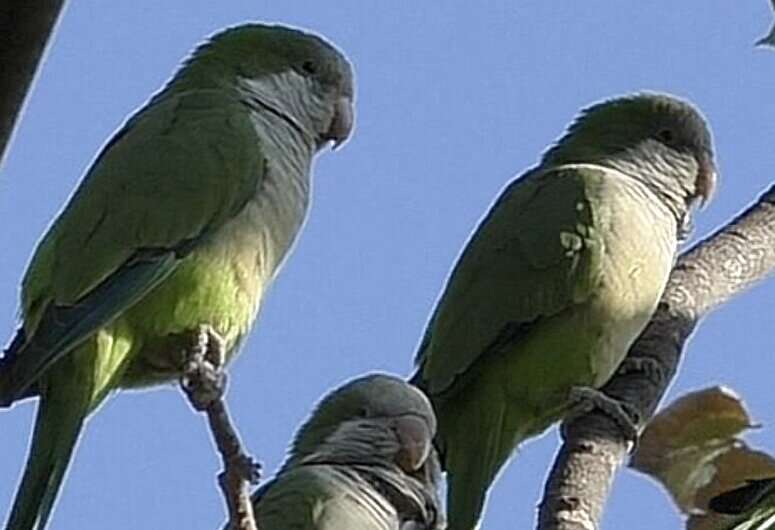This article has been reviewed according to Science X's editorial process and policies. Editors have highlighted the following attributes while ensuring the content's credibility:
fact-checked
peer-reviewed publication
trusted source
proofread
Unique voice prints in parrots could help birds be recognized in a flock, no matter what they say

Parrots are exceptional talkers. They can learn new sounds during their entire lives, amassing an almost unlimited vocal repertoire. At the same time, parrots produce calls so they can be individually recognized by members of their flock—raising the question of how their calls can be very variable while also uniquely identifiable.
A study on monk parakeets conducted by the Max Planck Institute of Animal Behavior and Museu de Ciències Naturals de Barcelona might have the answer: individuals have a unique tone of voice, known as a voice print, similar to that in humans. This finding in a wild parrot raises the possibility that a voice print might also be present in other vocally flexible species, such as dolphins and bats.
"It makes sense for monk parakeets to have an underlying voice print," says the Max Planck's Simeon Smeele, first author on the paper published in Royal Society Open Science. "It's an elegant solution for a bird that dynamically changes its calls but still needs to be known in a very noisy flock."
Humans have complex and flexible vocal repertoires, but we can still recognize each other by voice alone. This is because humans have a voice print: our vocal tract leaves a unique signature in the tone of our voice across everything that we say.
Other social animals also use vocal cues to be recognized. In birds, bats, and dolphins, for example, individuals have a unique "signature call" that makes them identifiable to members of the group. But signature calls encode identity in only one call type. To date, almost no evidence exists for animals having unique signatures that underlie all calls made by an individual. In other words, almost no animals are known to have a voice print.
That surprised Smeele, a doctoral researcher at the Max Planck Institute of Animal Behavior who studies how parrots use their exceptional vocal abilities to socialize in large groups. Like humans, parrots use their tongue and mouth to modulate calls, meaning that "their grunts and shrieks sound much more human than a songbird's clean whistle," he says.
Also, like humans, parrots live in large groups with fluid membership. "There could be tens of birds vocalizing at the same time," he says. "They need a way of keeping track of which individual is making what sound."
Smeele wondered if parrots, possessing the right anatomy coupled with a need to navigate complex social lives, might have evolved voice prints, too. To find out he traveled to Barcelona where the largest population of individually marked parrots exists in the wild. The monk parakeets there are invasive and swarm the city's parks in flocks that number hundreds of birds.
A monitoring program run by Museu de Ciències Naturals de Barcelona has been marking the parakeets for 20 years, with 3000 birds individually identified so far—a boon for Smeele and his study on individual voice recognition.
Armed with shotgun microphones, Smeele and colleagues recorded the calls of hundreds of individuals, collecting over 5000 vocalizations in total, making it the largest study of individually-marked wild parrots to date. Importantly, Smeele re-recorded the same individuals over two years, which revealed how stable the calls were over time.
They then used a set of models to detect how recognizable individuals were within each of the five main call types given by this species. Surprisingly, they found high variability in the so-called "contact call" that birds use to broadcast their identity. This overturned a long-held assumption that contact calls contain a stable individual signal—and suggested that the parakeets are using something else for individual recognition.
To test if voice prints were at play, Smeele turned to a machine learning model widely used in human voice recognition, which detects the identity of the speaker using the timber of their voice. They trained the model to recognize calls of individual parrots that were classed as "tonal" in sound.
Once the model was trained on an individual, they then tested to see if the model could detect the same individual from a different set of calls that were classed as "growling" in sound. The model was able to do this three times better than expected by chance, providing evidence that monk parakeets have a voice print, which Smeele says "could allow individuals to recognize each other no matter what they say."
The authors caution that the evidence is still preliminary. "Before we can speak of a true voice print, we need to confirm that the model can repeat this result when it is trained with more data from more individuals, and that birds can also recognize this timbre in the vocalizations," says Smeele.
The Barcelona team would complement the future experiments and analyses with an ecological study, tagging parrots with GPS devices to determine how much individuals overlap in their roaming areas.
"This can provide insight into the species' remarkable ability to discriminate between calls from different individuals," says Juan Carlos Senar from the Museu de Ciències Naturals de Barcelona.
And if it turns out that monk parakeets have a true voice print, Smeele says this would provide an answer to the question of how parrots can both be so vocally flexible and social at the same time. The implications would go beyond parrots, too: "I hope that this finding prompts more work to uncover voice prints in other social animals that can flexibly modify their vocalization, such as dolphins and bats," he says.
More information: Simeon Smeele et al, Evidence for vocal signatures and voice-prints in a wild parrot, Royal Society Open Science (2023). DOI: 10.1098/rsos.230835. royalsocietypublishing.org/doi/10.1098/rsos.230835
Journal information: Royal Society Open Science
Provided by Max Planck Society


















